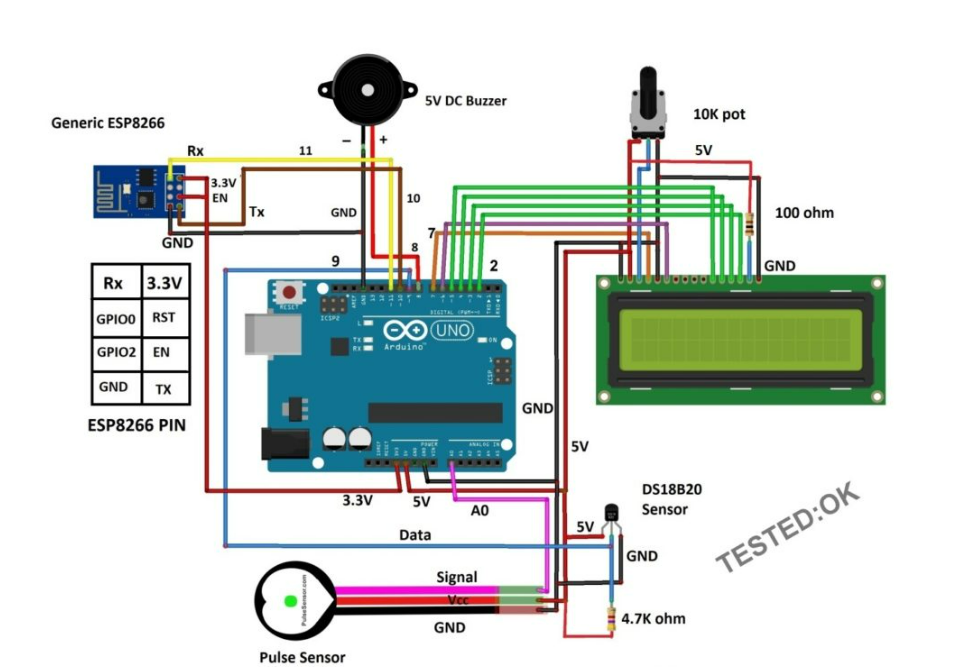
A Health Monitoring System (HMS) is a technology-driven system designed to track and monitor various health parameters of individuals in real-time. These systems are used in hospitals, healthcare facilities, fitness centers, and at home for continuous health tracking. They help in diagnosing conditions, predicting potential health issues, and ensuring that individuals receive timely interventions. Below is a breakdown of the components, types, and applications of a Health Monitoring System:
1. Components of a Health Monitoring System
- Sensors: These devices collect real-time data about an individual’s health, such as heart rate, blood pressure, body temperature, oxygen levels (SpO2), glucose levels, ECG readings, etc. Examples include:
- Heart Rate Sensors (e.g., electrocardiogram (ECG) sensors)
- Blood Pressure Monitors
- Temperature Sensors
- Glucose Monitoring Devices
- Pulse Oximeters (for blood oxygen levels)
- Accelerometers (to track movement and physical activity)
- Data Transmission: Data collected from the sensors is transmitted to a central server or application via Bluetooth, Wi-Fi, or cellular networks. In some cases, this data is stored in cloud-based systems for remote access and analysis.
- Processing Unit: This is the core of the system where the data is analyzed, either on the device itself or in the cloud. Algorithms and machine learning models may be used to detect abnormalities or trends in the data.
- User Interface: The collected data is displayed through a user-friendly interface. It could be a mobile app, a website, or a healthcare portal that provides real-time readings and insights for users, doctors, or caretakers.
- Alert System: If any health parameter deviates from the normal range (e.g., high blood pressure, irregular heart rate), the system sends alerts to the user or healthcare professionals, triggering timely medical interventions.
2. Types of Health Monitoring Systems
- Wearable Health Monitoring Devices: These are typically small, portable devices such as smartwatches or fitness trackers that continuously monitor an individual’s health metrics (e.g., Fitbit, Apple Watch, Garmin).
- Remote Patient Monitoring (RPM): These systems allow healthcare professionals to monitor patients’ health remotely. They are often used for patients with chronic diseases such as diabetes, hypertension, or cardiovascular conditions.
- Hospitals and Clinics: In a clinical setting, health monitoring systems are used for intensive care units (ICUs), emergency rooms, or routine check-ups. Devices such as ECG machines, blood glucose monitors, and pulse oximeters are often used in combination to monitor patient conditions.
- Home Health Monitoring: Consumers use these systems at home to track their health parameters and send this data to healthcare professionals if necessary. This is especially useful for elderly individuals or patients with chronic conditions.
3. Applications of Health Monitoring Systems
- Chronic Disease Management: Helps manage diseases such as diabetes, hypertension, asthma, etc., by monitoring vital signs and ensuring that medications are taken properly.
- Elderly Care: Provides peace of mind for families by enabling real-time monitoring of elderly individuals, detecting falls, or sending alerts when health indicators reach dangerous levels.
- Fitness & Wellness: Used by individuals to monitor their fitness levels, track exercise routines, and ensure overall well-being.
- Emergency Situations: In critical situations, health monitoring systems can provide real-time data that is vital for emergency responders.
- Telemedicine: Integrated into telemedicine solutions, these systems provide doctors with data for remote consultations, diagnosis, and treatment.
4. Benefits of Health Monitoring Systems
- Early Detection of Health Issues: Continuous monitoring helps detect health conditions before they become critical, allowing for preventive measures and timely interventions.
- Improved Healthcare Outcomes: With real-time data, healthcare providers can make more informed decisions, improving overall patient care and outcomes.
- Cost-Effective: These systems can reduce the need for frequent doctor visits, as patients can be monitored remotely, saving time and healthcare costs.
- Convenience and Accessibility: Users can easily track their health metrics and share them with healthcare providers from the comfort of their homes.
- Empowerment and Self-Care: Patients can take control of their health, learning more about their conditions and engaging in better self-care practices.
5. Challenges and Limitations
- Data Privacy and Security: Handling sensitive health data requires strict security measures to protect patient privacy.
- Accuracy of Data: Some sensors may have limited accuracy or can be influenced by external factors, leading to unreliable results.
- Integration: Integration of various health data sources (from different devices) into a single platform can be challenging.
- Cost of Equipment: Advanced health monitoring devices may be expensive, making them inaccessible to some users or healthcare providers.
6. Future Trends
- AI and Machine Learning: Advanced algorithms will improve the predictive capabilities of health monitoring systems, making them more accurate in detecting potential health issues.
- IoT Integration: The integration of the Internet of Things (IoT) will allow different devices to work seamlessly, providing more holistic health tracking.
- Personalized Healthcare: Tailored health insights and treatments based on an individual’s data will become more prevalent.
- Integration with Electronic Health Records (EHR): The seamless integration of health monitoring data with EHR systems will provide doctors with a more comprehensive view of a patient’s health history.
In conclusion, health monitoring systems are a powerful tool for improving patient care, enabling proactive management of chronic conditions, and promoting overall wellness. As technology continues to evolve, the scope of these systems will expand, offering more personalized, efficient, and accessible healthcare solutions.

Leave a Reply